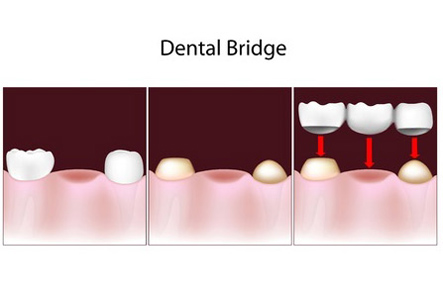3 Unit Dental Bridge
Introduction
A 3 unit dental bridge is an excellent technique of restoration utilized for replacement of missing tooth. It adheres to contiguous teeth or other implants in a permanent manner.
It is standard dental treatment to replace a missing tooth by a 3-unit bridge. A unit describes a tooth, so a 3-unit bridge denotes a 3 tooth bridge. The underside of this bridge is hollow where the natural teeth insert. These hollowed sites are called as abutments. The middle missing tooth site is solid material (usually porcelain fused to metal) and is called as a pontic.
For the success of a 3 unit bridge, the supporting teeth need to be healthy with good alveolar bone surrounding them. In this case, only 2 teeth are supporting a 3 tooth restoration. Therefore, if the supporting teeth are having a periodontal disease (such as loss of bone due to gum disease), they cannot readily support the bridge.
Purpose of 3 Unit Dental Bridge:
1. It replaces the missing teeth and is fully functional when biting and chewing.
2. It also helps to improve speaking affected by a missing tooth.
3 unit bridges can last for as many as ten years or more if good oral hygiene is maintained.

3. The crowns supporting the bridge help in repair of the adjacent teeth which may be previously damaged by cavities.
4. Crowns also protect the adjacent teeth from more cavities.
5. The 3 unit dental bridge prevents the contiguous teeth from shifting in a place created by missing teeth. Change of bite, sore jaws and problems in the temporo-mandibular joint as a result of this shifting can be prevented.
6. Missing teeth also compromise dental and oral hygiene causing tooth decay and various gum diseases. This is prevented by three Unit Bridge.
Procedure
1. The dentist first prepares the teeth on either side of the defect left by a missing tooth. A mild anesthetic is injected to numb the area.
2. The dentist also places a device called a rubber dam in your mouth that keeps debris from falling into your throat during the procedure.
3. The dentist then uses a hand piece to scrape away tartar and decay from the teeth that will later be used as support the three-unit bridge.
4. Enough space is made between the teeth on either side so as to accommodate the thickness of the crown. If these teeth have fillings, it can be used as a foundation for the crown.
5. The dentist makes an impression, from which the bridge, false tooth and crowns are made in a dental laboratory.
6. Until the next visit, patient is made to wear a temporary bridge. This temporary bridge protects the teeth and gums till the permanent bridge is made. Or else, a Flipper appliance is used in the place of missing tooth till the permanent bridge is placed. A Flipper is a false tooth attached via either a wire or a plastic piece to the roof of the mouth awaiting the new 3 unit bridge.
7. On the second visit, the temporary bridge is removed and new permanent bridge is fitted and checked and adjusted for any bite problems. If none, the new bridge is cemented to the teeth permanently.
Advantages of 3 Unit Dental Bridge:
1. These bridges look natural in appearance.
2. Generally only two visits are required for this procedure.
3. 3 unit bridges can last for as many as ten years or more if good oral hygiene is maintained.
Disadvantages of having a dental bridge:
1. The teeth can become mildly sensitive to extreme temperatures for a few weeks after the bridge placement
2. If proper oral hygiene is not maintained, the growth of bacteria formed from food acids on teeth and gums can become infected.
3. Cost of the procedure must also be weighed against its advantages.
Home care:
1. Daily brushing and washing with a mouth rinse should be done.
2. Avoid hot foods and also avoid biting the lip or gums till the area is numb.
3. Special soft picks are available to clean the teeth.
4. Ice, hard candy and sticky foods such as chewing gum should be eaten with caution or avoided completely.
5. Proper flossing should be done routinely with special floss.
6. Visit a dentist at least twice a year.